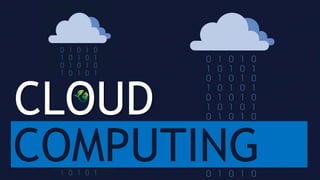Cloud Computing.pptx
•
1 gostou•100 visualizações
Cloud computing refers to storing and accessing data and applications over the internet instead of a local computer's hard drive. It has two parts - the front end used by clients and the back end used by service providers. There are different types of cloud computing including public, private, community, and hybrid clouds. Cloud services provide infrastructure, platforms, and software as services. Cloud computing provides advantages like collaboration, mobility, unlimited storage, and low costs. Some applications that use cloud computing include editing software, file converters, e-commerce, and data storage.
Denunciar
Compartilhar
Denunciar
Compartilhar

Recomendados
Recomendados
Mais conteúdo relacionado
Mais procurados
Mais procurados (20)
What Is Cloud Computing? | Cloud Computing For Beginners | Cloud Computing Tr...

What Is Cloud Computing? | Cloud Computing For Beginners | Cloud Computing Tr...
Enterprise Cloud Governance: A Frictionless Approach

Enterprise Cloud Governance: A Frictionless Approach
Semelhante a Cloud Computing.pptx
Semelhante a Cloud Computing.pptx (20)
Cloudcomputingsimpleppt 141114085742-conversion-gate01 (1)

Cloudcomputingsimpleppt 141114085742-conversion-gate01 (1)
cloudcomputingsimpleppt-141114085742-conversion-gate01

cloudcomputingsimpleppt-141114085742-conversion-gate01
Último
Último (20)
Cloud Frontiers: A Deep Dive into Serverless Spatial Data and FME

Cloud Frontiers: A Deep Dive into Serverless Spatial Data and FME
Rising Above_ Dubai Floods and the Fortitude of Dubai International Airport.pdf

Rising Above_ Dubai Floods and the Fortitude of Dubai International Airport.pdf
Apidays New York 2024 - The value of a flexible API Management solution for O...

Apidays New York 2024 - The value of a flexible API Management solution for O...
Finding Java's Hidden Performance Traps @ DevoxxUK 2024

Finding Java's Hidden Performance Traps @ DevoxxUK 2024
TrustArc Webinar - Unlock the Power of AI-Driven Data Discovery

TrustArc Webinar - Unlock the Power of AI-Driven Data Discovery
DEV meet-up UiPath Document Understanding May 7 2024 Amsterdam

DEV meet-up UiPath Document Understanding May 7 2024 Amsterdam
Exploring the Future Potential of AI-Enabled Smartphone Processors

Exploring the Future Potential of AI-Enabled Smartphone Processors
ProductAnonymous-April2024-WinProductDiscovery-MelissaKlemke

ProductAnonymous-April2024-WinProductDiscovery-MelissaKlemke
Why Teams call analytics are critical to your entire business

Why Teams call analytics are critical to your entire business
Apidays New York 2024 - Scaling API-first by Ian Reasor and Radu Cotescu, Adobe

Apidays New York 2024 - Scaling API-first by Ian Reasor and Radu Cotescu, Adobe
ICT role in 21st century education and its challenges

ICT role in 21st century education and its challenges
Cloud Frontiers: A Deep Dive into Serverless Spatial Data and FME

Cloud Frontiers: A Deep Dive into Serverless Spatial Data and FME
Emergent Methods: Multi-lingual narrative tracking in the news - real-time ex...

Emergent Methods: Multi-lingual narrative tracking in the news - real-time ex...
Repurposing LNG terminals for Hydrogen Ammonia: Feasibility and Cost Saving

Repurposing LNG terminals for Hydrogen Ammonia: Feasibility and Cost Saving
Apidays New York 2024 - The Good, the Bad and the Governed by David O'Neill, ...

Apidays New York 2024 - The Good, the Bad and the Governed by David O'Neill, ...
Cloud Computing.pptx
- 2. WHAT IS CLOUD ? The term Cloud refers to a Network or Internet. Cloud provides services over public or on private networks. Cloud applications runs in cloud online, such as: Microsoft 365 Drop Box Google Drive
- 3. Cloud Computing refers to manipulating, configuring, and accessing the applications online. Cloud Computing is both a combination of software and hardware based computing resources delivered as a network service. WHAT IS CLOUD COMPUTING ?
- 4. Cloud computing architecture is divided in two parts – • Front End Used by the client. • Back End Used by the service provider. CLOUD COMPUTING ARCHITECTURE
- 5. Client Infrastructure Application Service Runtime Cloud Storage Infrastructure Management Security Internet CLOUD COMPUTING ARCHITECTURE COMPONENTS
- 7. PUBLIC CLOUD Public cloud is open to all to store and access information via the Internet using the pay-per-usage method. CLOUD COMPUTING TYPES PRIVATE CLOUD Private cloud is also known as an internal cloud or corporate cloud used by organizations to build their own data centers internally or by the third party.
- 8. COMMUNITY CLOUD Community cloud allows systems and services to be accessible by a group of several organizations to share the information. CLOUD COMPUTING TYPES HYBRID CLOUD Hybrid Cloud is a combination of the public cloud and the private cloud. We can say: Hybrid Cloud = Public Cloud + Private Cloud
- 9. CLOUD COMPUTING SERVICE MODELS Infrastructure as a Service (IaaS) It is a computing infrastructure managed over the internet. Platform as a Service (PaaS) Created for the programmer to develop, test, run, and manage the applications. Software as a Service (SaaS) It is a software in which the applications are hosted by a cloud service provider.
- 10. FEATURES OF CLOUD COMPUTING
- 11. APPLICATIONS OF CLOUD COMPUTING Editing Software File Converters Anti-Virus Applications E-commerce Application Business Backup and Recovery
- 12. APPLICATIONS OF CLOUD COMPUTING Art Applications Data Storage Education Applications Entertainment Management Social Applications
- 13. ADVANTAGES: Back-up and restore data Improved collaboration Excellent accessibility Low maintenance cost Mobility Unlimited storage capacity Data security ADVANTAGES & DISADVANTAGES DISADVANTAGES: Internet Connectivity Limited Control Security Downtime
- 15. CLOUD BASED APPLICATION SOFTWARES
- 16. CONCLUSION Cloud computing is increasingly becoming the new normal. Cloud computing is helping the society to cope with future problems such as managing big data, cyber-security and quality control. Emerging technologies such as Artificial Intelligence, distributed ledger technology, and many other capabilities are becoming available as services through cloud computing. The final verdict for cloud computing is that it’s a transformational technology that has helped organizations in different jurisdictions to deliver their products and services in a better way than before.
- 17. THANK YOU THANK YOU ANY QUESTIONS ? PREPARED BY: SUBID BISWAS
